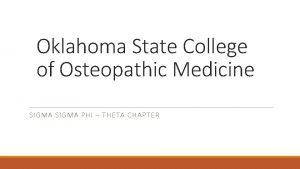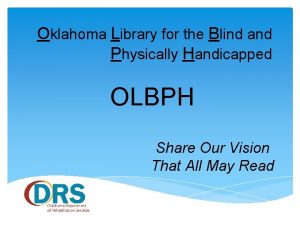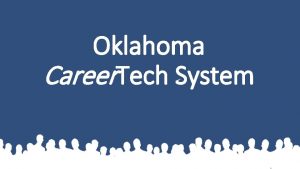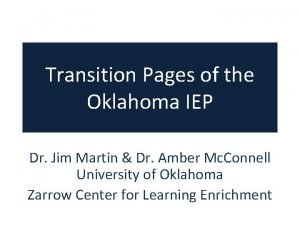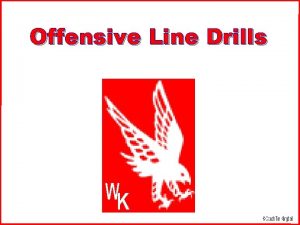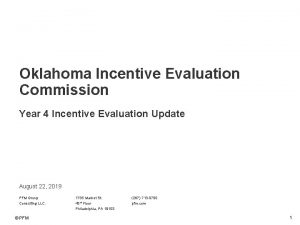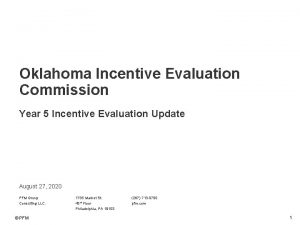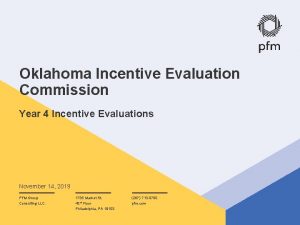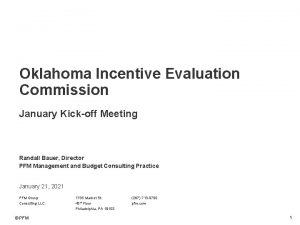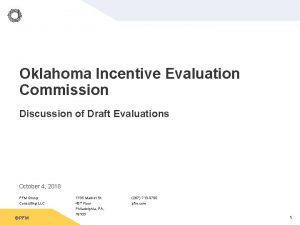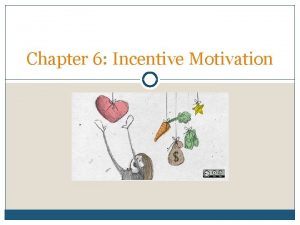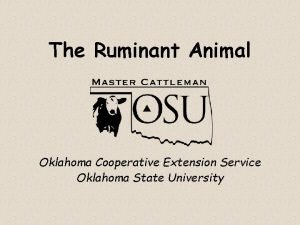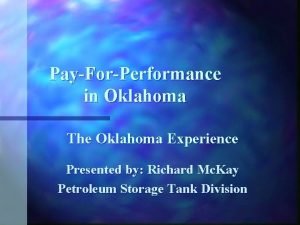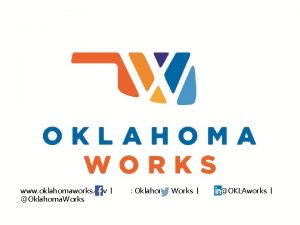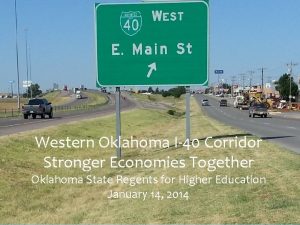Oklahoma Incentive Evaluation Commission Year 5 Incentive Evaluation

















- Slides: 17

Oklahoma Incentive Evaluation Commission Year 5 Incentive Evaluation Update October 1, 2020 PFM Group Consulting LLC. © PFM 1735 Market St. 43 rd Floor Philadelphia, PA 19103 (267) 713 -0700 pfm. com 1

Today’s Agenda § Update: project activities to date. § Overview of 2020 draft evaluations. § Next steps. © PFM 2

Update: Project Activities to Date § The project team is on schedule for all project deliverables. ‒ The national pandemic led to the cancellation of the April meeting and forced the project team to conduct all project activities by remote calls/video meetings. ‒ The project team was able to update the Commission on benchmarking and project activities via a virtual Commission meeting in June. ‒ Working drafts were provided in August, and the Commission was updated in September. ‒ This week, the Commission received draft evaluations for all incentives up for review this year. § All evaluations have been provided ahead of the October 1 deadline © PFM 3

Evaluations Evolution: Second Time Modifications § Includes a summary of the 2016 evaluation ‒ Table that includes answers to the ‘key questions’ required by the incentive evaluation statute. ‒ Explanation of changes (such as legislative) since the prior evaluation § Notes instances of incentive layering § Provides more discussion of the issues around economic impact § Includes statutory language related to the incentive © PFM 4

Evaluations Evolution: Holistic Perspective § The incentive evaluation statute requires each to be considered on its own merits by its own specific criteria § At the same time, all incentives are not ‘created equal’ ‒ Based on financial and economic impact ‒ Based on impact on key sectors, communities, or areas of need § Embodied in some of what the Department of Commerce is considering in its review of state incentives § The project team is cognizant of this, and the discussion of incentives is presented in our judgement of the rough order of magnitude of each § Eventually, the evaluations statute might wish to recognize this and provide for some method of evaluating incentives in relationship to each other © PFM 5

Five Year Ad Valorem Tax Exemption § Key Findings - From FY 2106 to FY 2020, total exemption reimbursements more than doubled, from $80 million to $161 million; - Qualifying facilities increased payroll by an average of $249 million – a 10. 3 percent increase; - Increased costs have not coincided with significant employment increases - Exempt property accounted for nearly 90 percent of all manufacturing capital expenditures in 2016; - Exemptions generally provide a positive net return for the State; - Wind turbines and computer data facilities have fueled recent growth - The program has greater benefit and fewer requirements than similar programs in other states. § Recommendation: Retain, with modifications - Establish more targeted program requirements (wages, specific industries); - Increase notice and reporting requirements; - Consider methods to increase local financial involvement. © PFM 6

Tax Credit for Zero Emissions Facilities § Key Findings - From FY 2012 to FY 2019, total credits used increased from $2 to $88 million; - Credits will continue to generate credits through 2026; - Program sunset avoided a potential $177 million in credit claims for 2018 facilities alone; - There is little ongoing employment benefit associated with the facilities; - The program met its stated purpose (energy diversification) but at a significant State cost; - There are local benefits as well that are captured in the economic impact analysis but not in the financial impact analysis; - Wind electricity capacity has continued to increase following the end of the credit. § Recommendation: Retain the existing sunset. © PFM 7

Aerospace Employer and Employee Tax Credits § Key Findings - Data shows an increase in related degrees conferred within the State; - There has been a significant increase in engineering employment since introduction of the tax credits; - While the employer tax credit is being claimed by more employers, the cost to the State is declining; - Use of the employee tax credit has increased – and the cost to the State has grown commensurately; - The incentive’s accreditation requirement has led to confusion among some employees claiming the credit; - The total economic activity associated with the tax credits substantially exceeds the cost to the State each year. § Recommendation: Retain - The State should consider changes to the accreditation requirements; - There also reporting requirement changes that would enhance the information available for evaluation. © PFM 8

Film Enhancement Rebate § Key Findings - The number of Oklahoma-based production companies and employees associated with the rebate is increasing significantly; - While total qualified payroll associated with incentive productions increased between FY 2013 and FY 2019, the average below the line (BTL) employee wage growth declined; - Anticipated FY 2020 productions indicated a significant increase in production activity, but the actual amount of the activity is unclear; - While there is positive economic activity, the return to the State in terms of tax revenue is negative; - A key unanswered question is whether associated state businesses will develop and attain/maintain roots. - The State agency responsible for the program has improved data collection and administration. § Recommendation: Retain but monitor - The current year disruption and the recent program expansion suggest a need for additional time and data. © PFM 9

Historic Rehabilitation Tax Credit § Key Findings - Between 2014 and 2018, claims activity decreased - returns filed declined by 15 percent, and the total amount claimed declined by 20 percent; - Changes to federal tax law may be impacting the use of the credit, as timing for taking the credit has changed from one to five years; - The credit is increasingly combined with the State’s affordable housing tax credit, which is also allowable under for the federal-level incentive; - While there is positive economic activity, the return to the State in terms of tax revenue is negative – which doesn’t account for local revenue or other positive impacts; - While there are no program caps in place, recent experience suggests this is not a significant concern; - Because of the federal ‘piggyback, ’ the program is effectively administered. § Recommendation: Retain © PFM 10

Industrial Access Road Program § Key Findings - This is a limited program – it provided $5. 8 million in funding to 9 qualified road projects across 6 counties from FY 2015 through FY 2019; - Program funds are appropriated to ODOT, limiting concerns about its financial impact; - Appropriated $2. 5 million annually but has not awarded its full appropriation in any year from FY 2015 through FY 2019. Average funding awarded per year was $1. 2 million; - Costs relative to capital investment and job creation vary widely, from 0. 3 percent to 21. 0 percent of capital investment and $500 to $59, 500 per job; - The Oklahoma Department of Transportation does not collect information related to average wages or total payroll. § Recommendation: Retain, with modifications - Incorporate assistance from the Department of Commerce to evaluate the economic impact of projects that are applying for funding; - Create a standard form for application and collect data on jobs, payroll and capital investment associated with the incentive. © PFM 11

Quality Events Program § Key Findings - Communities have been reimbursed $1. 3 million for 32 events from FY 2015 through FY 2020. - This amounts to 7. 2 percent of the statutory maximum during this time period (10 cases that are pending reimbursement); - The length of time for disbursement runs from 1 to 27 months; - The retained events data is limited, and the economic impact cannot be determined. § Recommendation: Retain, with modifications - Replace “actual documentation” with a standardized form that identifies all the information needed to determine economic impact; - Remove the statutory requirement that host communities submit the actual documentation 30 days after the event ends; - Collect additional data - number of event attendees, number of event participants, length of the event, ratio of local to non-overnight attendees, ratio of local to non-overnight participants, average daily spending. © PFM 12

Oklahoma Capital Investment Board (OCIB) § Key Findings - OCIB’s Venture Investment Program has made funding commitments to 19 venture capital funds, totaling $69. 5 million; - As of FY 2018, OCIB-supported funds invested a total of more than $171. 0 million into 38 Oklahoma-based companies. With total OCIB support of $65. 9 million, $2. 59 was invested in Oklahoma-based companies for every dollar funded by OCIB, exceeding its statutory requirement of $2. 00; - Four venture funds totaling $21. 1 million did not invest in any Oklahomabased firms; - Total cost to the State as of FY 2019 was $39. 2 million with potential additional costs estimated at $6. 2 million; - All tax credits sold by OCIB were sold as part of agreements entered into prior to 1996, meaning state statute does not place a limit on their carryforward period. § Recommendation: Retain the existing program sunset - The goals of OCIB are currently advanced by State programs that are better aligned with the principles of well-designed state venture capital programs. © PFM 13

Excise Tax Exemptions on Aircraft Sales § Key Findings - Annual state aircraft sales and associated total sales prices have decreased in recent years. The number of aircraft sold in Oklahoma decreased from 369 in FY 2015 to 205 in FY 2019; - Aircraft sales exempt from the excise tax have also decreased. The number decreased from 54 in FY 2015 to 14 in FY 2019; - Growth in employment in the aerospace and parts manufacturing industry is increasing. Between 2009 and 2019, it grew by 10. 7 percent – significantly higher than in neighboring states; - There is insufficient information to assess the economic impacts of the excise tax exemption on aircraft sales; - Similar exemptions are common among comparable states. § Recommendation: Reconfigure with a specific policy goal © PFM 14

Pew State Tax Incentive Evaluation Ratings (August 2019): Oklahoma Still a ‘Leading’ State Pew State Assessment 2017 © PFM Source: Pew Charitable Trusts: State Tax Incentive Evaluation Ratings 15

Next Steps § As required by statute, the Commission must hold at least one public hearing between October 1 and November 30. § By December 15, the Commission must provide its written report to the Governor and the Legislature. § By December 31, the Commission must provide its schedule of incentives for review in the next four-year period. § If you wish to do so, PFM’s contract with the State requires annual renewal. © PFM 16

Questions and Discussion © PFM 17
 Secondary education commission (1952-53)
Secondary education commission (1952-53) Marie earns an 8 commission
Marie earns an 8 commission Poems about leaving school
Poems about leaving school Brant and associates
Brant and associates Oklahoma city bombing
Oklahoma city bombing Dr courtney mapes
Dr courtney mapes Jake bluff site oklahoma
Jake bluff site oklahoma Oklahoma parent center
Oklahoma parent center Oklahoma library for the blind
Oklahoma library for the blind Oklahoma career tech programs
Oklahoma career tech programs Longitude
Longitude Oklahoma iep
Oklahoma iep Oklahoma teacher certification renewal
Oklahoma teacher certification renewal Special education handbook oklahoma
Special education handbook oklahoma Reza foudazi oklahoma
Reza foudazi oklahoma How oklahoma boom
How oklahoma boom Are oklahoma drills illegal
Are oklahoma drills illegal Charge volleyball
Charge volleyball





